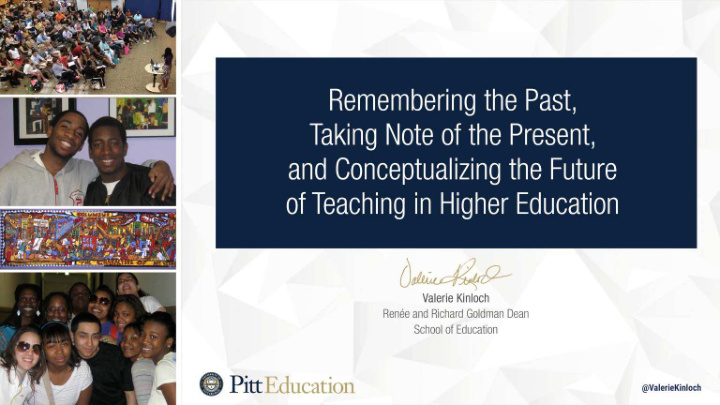



Framing Teaching As: • Culturally relevant/responsive teaching: • Gay, 2000, 2002 • Ladson-Billings, 1995, 2014 • Culturally affirming instruction: • Delpit, 1988, 2012 • Lee, 1995 • Culturally sustaining pedagogy : • Kinloch, 2017 • Paris & Alim, 2014, 2017
Higher Education: What We Know • Uncerta taintie ties & & challe llenges with: • Shifting student enrollments • Increasing our diverse student & faculty population • Barriers to college attendance, completion, costs • Need to imple leme ment t ways to: • Support our teaching & NTS faculty • Enhance access & affordability • Establish partnerships (provide access to U/G/P Ed)
Teaching: What We Know • Teachin ing & & learnin ing as connected to: • Innovation, creativity & new teaching technologies • Developing global mindsets • Relations between self & world • Competencies that prepare us to live interdependently
Teaching: What We Know • Cultivate & support diverse student & faculty populations • Foster connections focused on: • Academic experiences • Technological advancements • Engaged learning & collaborations • Intellectual power of teaching • Lifelong learning
Learning from Rebecca
Teaching: What We Know • “There’s nothing more worthy of praise than teaching. Nothing.” • “If you’re teaching…that’s what it’s all about.” • “What am I teaching today? What am I teaching right now?
Remembering the Past “Education within a pluralistic democratic society should help students to gain the content, attitudes, and skills needed to know reflectively, to care deeply, and to act thoughtfully” Banks & Banks, 1995, p.152
Taking Note of the Present By “participating in a pluralistic community, talking and making decisions w/one another, and coming to understand multiple perspectives” Darling-Hammond, 1996, p.6
Conceptualizing the Future By viewing teaching as: “Something truthful within those moments we co-construct together not in spite of our differences, but because of them” and as “opportunities—particularly in schooling spaces—to be heard in meaningful ways” San n Pedr dro, 2 2017, p. p. 113
Some Considerations • Implement equitable, institutional structures to: • Incentivize teaching • Increase access & opportunity • Evaluate & reward “good” teaching/teachers • Support teaching as lifelong learning
Some Considerations • Implement equitable, institutional structures to: • Encourage inter- & multi-disciplinary collaborations • Support diverse practitioners, practices & learners • “Equalize” the playing field • Challenge cultural hegemony, individuality, meritocracy
Some Considerations • Implement equitable, institutional structures to: • Foster equitable, implementable policies & practices • Become “a university that embodies diversity and inclusion as core values that enrich learning, scholarship, and the communities we serve” (Gallagher)
Higher Education & Teaching Policy Access Engagement • Incentivize Teaching Fac • Curricular Planning • Diversity/Teaching Equity • Affordability/Higher Ed • Professional Development • Addressing Disparities • Online/Hybrid Learning • Mentoring in & w/Teaching • Having Institutional Goals • Community/Partner Access • Teaching Conversations Challenges Resources Geographies • Teaching Funding Streams • Active Learning & Student- & • Admin Teaching Support Centered Teaching Spaces • Campus/Unit Orientations, Opportunitie • Professional Communities Workshops, Demonstrations • Inside/Outside Univ Spaces s Innovation New Frontiers Evaluation • Interdisciplinary Teaching • Improved Climate & Culture • Equitable Promotion Processes • Online/Hybrid Teaching • Reimagine Service Courses • Teaching-Intensive TS Positions • Teaching Excellence/Recog • No Adjunctification of H.E. • Creativity (evaluating teaching)
Recommend
More recommend